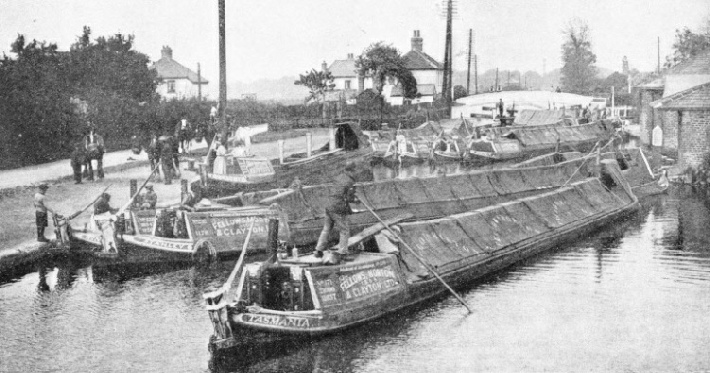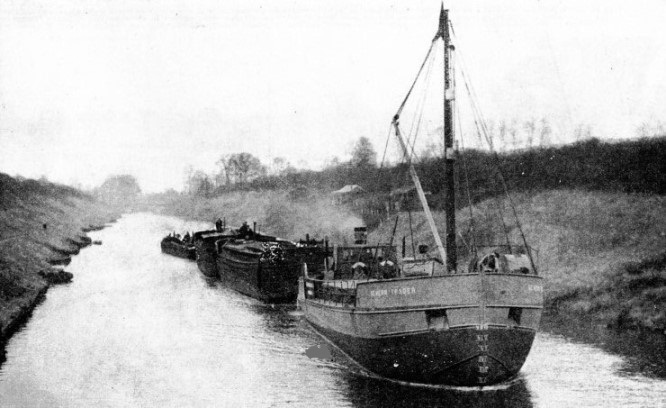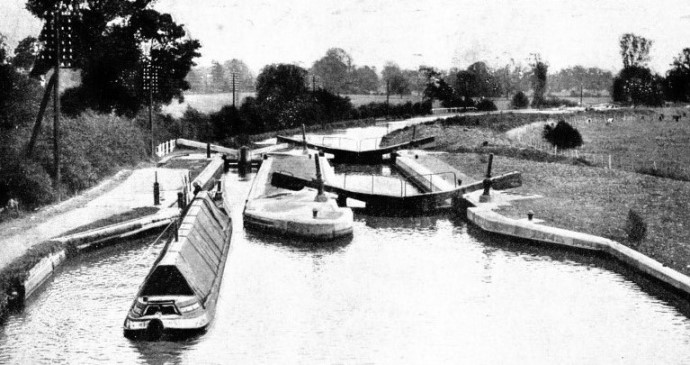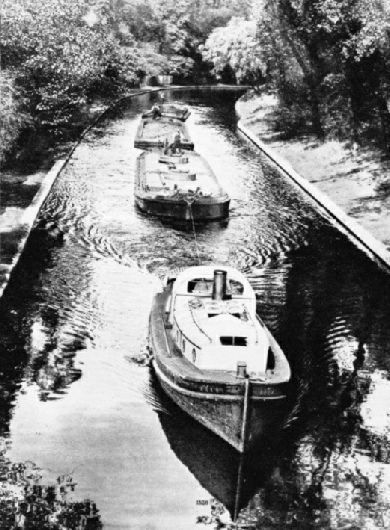

© Shipping Wonders of the World 2012-

Britain’s Canal System
The victim of uncontrolled speculation before the coming of railways, the British canal system was never used to the best advantage. Co-
IN THE HEART OF LONDON the Regent’s Canal passes through quiet scenes on its course between the warehouses and traffic of Paddington and the wharves and docks of the Port of London, a distance of 84 miles. Completed in 1820, the Regent’s Canal linked the London Docks with the Grand Junction Canal, thus affording another direct outlet by water for the goods of Birmingham and the industrial Midlands.
AS there are no canals in Great Britain to be compared in size with many of those in the United States and on the Continent, there is a tendency to look down upon British artificial inland waterways and to regard them as little more than a delightful feature of the landscape seen from the window of a passing train.
The canal system has gone through some bad times and has more than once been threatened with total eclipse, but it is of far more importance than many people imagine and at the present time has every prospect of a revival. This revival is planned not only to give the cheapest internal transport to manufacturers and producers, but also to be run in conjunction with the biggest ports and overseas shipping.
At the present time there are roughly 2,500 miles of canals and canalized rivers in Great Britain, rather less than half of them being the property of, or controlled by, the railways. Some of the principal canal-
Great Britain is particularly lucky because almost every centre of population or production is within a few miles of navigable water. In the old days, however, when the roads were unsuitable for heavy loads and the railways were not yet thought of, it was necessary to improve on the natural features. It is impossible to say when the British canal system was started, but the navigable rivers were improved by canalization and supplemented by artificial waterways at an early date.
It was in the seventeenth century that the absolute necessity of improvement was realized. Until then the navigable rivers, the bridle paths and the few main roads had been sufficient for the transport of the country, but the demand was growing, especially because oi the rapidly increasing use of coal, which was expensive when carried by pack horse. Many Acts of Parliament were passed on the subject, but little was done because of the lack of money. In the eighteenth century matters became worse, for wheeled traffic was developing rapidly for passengers and merchandise and the roads became a major problem, especially in the winter, when their condition was appalling. It was essentially a time for a constructive policy for the assistance of trade, but the authorities contented themselves with periodical Acts restricting the type and size of vehicles using the roads. It was the poorest policy and British trade was expanding too rapidly at that time to stand the restriction for long.
So a great craze for the cutting of canals swept the country, and projects were launched by the dozen. Many of them were completed, many others were started and still more never got beyond the stage of relieving incautious speculators of their savings.
139½-
Among the innumerable projects were sufficient sound ones to make an immense difference to the trade of the country. The Duke of Bridgewater obtained two Acts of Parliament in 1758 and 1759 for the purpose of cutting a canal which would provide cheap transport for the coal raised on his estate at Worsley (Lancs) to Manchester, whose manufactures were expanding rapidly.
Brindley was the engineer, a brilliant man at his business. The Bridgewater Canal, opened in 1761, was 29 miles long and rather less than 5 feet deep, running straight across country without any locks. Later it was extended to Liverpool and when that section was completed goods could be carried between Liverpool and Manchester by canal at six shillings a ton against forty shillings by land.
The Bridgewater and similar canals showed the cheapness of water transport, opened up many isolated places just as effectively as the motor-
Having attracted attention by the building of the Bridgewater Canal, Brindley started the Grand Trunk Canal in 1766. It took eleven years to finish the work, the main difficulty being the labour of cutting the Harecastle Tunnel. The Grand Trunk Canal was 139½ miles long and ran from the Bridgewater Canal to the Trent Valley by way of the Potteries.
The Staffordshire and Worcester Canal was cut from Great Haywood on the Grand Trunk system and ran to Stourport on the River Severn, giving the Midlands direct connexion with Bristol. The Stroudwater Canal was 8 miles long from the River Severn at Framlode to Wallbridge, near Stroud, Gloucestershire.
The Stroudwater Canal was linked with the Thames at Lechlade by the 30-
Coventry, rapidly growing in importance, was connected with the Grand Trunk system by the Coventry Canal and with Oxford by the Oxford Canal. A close network of waterways soon existed round Birmingham, which probably gained more from the canal system than any other manufacturing centre. It was linked with all the districts of the industrial Midlands and also with the most important outlets for its products. The Leeds and Liverpool Canal was the most important of the canals opened in Lancashire and Yorkshire. In Scotland the development was slower, excepting for the Caledonian and Crinan Canals, which were both designed to shorten sea routes. The Forth and Clyde Canal, 1790, and the Edinburgh and Glasgow Canal, 1826, were both of great importance. The first canal in Wales was not opened until 1794. This was a 25-
By the opening of the Grand Junction Canal in 1805 the connexions between Birmingham and London were perfected. The main line ran from Braunston, on the existing Oxford Canal, in the county of Northampton, through mainly agricultural country until it joined the Thames at Brentford, Middlesex. To this main line many branches and extensions were soon added, so that the trade of the canal was vastly increased. The Regent’s Canal was completed in 1820 and linked a branch of the Grand Junction Canal at Paddington with the heart of the dock system of the Port of London. The Regent’s Canal, only 8½ miles long, immediately became busy, for it permitted Birmingham goods to be brought right alongside the ships which were taking them overseas. Among the innumerable schemes that were launched, the Grand Surrey Canal, now an integral part of the Surrey Commercial Dock system, is one of the most interesting. It was to have been the first part of a huge scheme. The promoters were going to cut a canal from the Greenland Dock to Epsom, Surrey, but when they had earned their shareholders a fortune with that section they intended to devote their profits to extending the canal down to Southampton, so that ships could avoid the tedious and dangerous passage up the English Channel to the London River. The canal was built as far as Camberwell, with a short branch to Peckham. Although it never had a chance in its original function of a canal, it is one of the busiest stretches of water in the Port of London, and the barge trade to the various warehouses and factories on its banks is colossal.
Missed Opportunities
Apart from their services to commerce in providing cheap transport, the canals were instrumental in getting the early steamboats their first chances. Patrick Miller tested his pioneer steamer on the Forth and Clyde Canal in 1789, and in 1802 the famous Charlotte Dundas, built under the patronage of Lord Dundas, successfully towed two barges on the canal and effectively scared the vested interests.
Any number of speculators lost their money in the canal craze, but the country gained immensely. Large areas well provided by Nature with everything except transport facilities were opened up to new industries and manufactures. Had town planning and amenities been better understood in those days the canals might have been accompanied by the best living facilities in the world, but the opportunity passed. Until the railways were developed for heavy cargo business the entire coal trade of the country had to depend on road or water transport. As road transport was impossible for more than a short distance for centuries, the only mining areas which prospered were those which were sufficiently close to the sea coast for easy loading into the colliers. The inland waterways, however, opened up the big fields in Staffordshire, Leicestershire, and other counties where large coal deposits were wasting for lack of markets. It is not surprising that the coal interests on the north-
The canals had a similar effect on the iron and pottery trades, collecting all the raw materials and distributing the products. The horse-
As the railways began to develop and compete for the traffic of the canals, beginning with the passenger and small parcels traffic, the water transport became more efficient. Barges travelled day and night, their design was improved to tow more easily, and the speed was increased by 50 per cent. Carrier firms were established and started to operate regular canal services all over the country.

TEMPORARY CONGESTION ON THE GRAND UNION CANAL was caused by the cleaning and renovation of Hanwell Lock, Middlesex. Such work is done speedily but holds up traffic for a short time. The Grand Union Canal Company was formed in 1929 and took control of the Regent’s Canal, the Grand Junction, Warwick and Birmingham and other canals The main line of canal under the new control is 147 miles, and numerous branches bring up the total length to 240 miles.
The carrier companies established van services to collect and deliver parcels at the various points on the canal, doubled the crews of their boats and organized a complete system whereby relays of horses were ready at all points. The coming of the railways broke the monopoly of the canals, and as soon as the railways had proved their possibilities canal charges came down with a run and the era of high profits was over.
Within fifteen years of the opening of the first commercially successful railway the market price of canal shares had dropped by over 50 per cent. Soon afterwards they were no longer considered to be a good investment, and the railways had no difficulty in picking up the canals which they wanted at practically their own prices. Some of the canals were bought and converted into railways, some ran in conjunction with the lines, and some were deliberately bought for destruction. By the early 1870s the railway companies owned nearly one-
By the beginning of the twentieth century there were hundreds of miles of canal in England which had been allowed to fall derelict, including the Basingstoke, Lower Avon, Grand Military, Kensington and the Thames and Medway Canals. Many of the canals which ceased to exist were not of the slightest use to commerce. Some of them were absolutely futile and would never have been built had it not been for the uncontrollable enthusiasm of speculators during the boom. The principal survivors were the Grand Junction Canal, nearly 200 miles long, the Leeds and Liverpool Canal, over 140 miles long, the Thames and Severn, the Rochdale, and the Oxford and Coventry Canals. Although they still had to fight railway competition no real effort had been made to secure co-
Problems of Hilly Country
An Act of 1888 provided for a clearing house for canal business, but it was allowed to remain a dead letter and few facilities were provided for through routes. Some of the canal companies acted as carriers over their waters, but most business was done by private carriers who paid their tolls in the same way as other users.
One of the greatest handicaps has always been the number of locks necessary to take a canal over hilly country. These locks not only account for a big proportion of the maintenance costs but they also waste a lot of the barges' time and cause more damage to floating material than any other factor. As there was no uniform scheme for building the canals the locks are all of different designs and sizes and many of them severely limit the dimensions of the barges which are to go through them. The cost of impounding sufficient water at the highest level of the canal to till all the locks is apt to be expensive. Thus when schemes of reconstruction are considered it is generally the cost of rebuilding the locks which defeats them.
When the early suggestions for building steamboats to tow barges on the canals were turned down, the adaptation of horse traction became general. One horse on the towpath is sufficient to draw through the water a heavy barge containing many times as much cargo as the same horse would be capable of moving on land. Alongside every canal, therefore, was built a towing path and it was only in special sections that the barges had to be “bow-
A badly kept towpath was always a great handicap to the horses, which were generally intelligent and knew their work well. The owner of the boat usually provides the horse and the skipper makes a great pet of him, but some companies have horses for hire.

A DIESEL-
Given that the canal is in reasonably good condition a horse-
The financial impossibility of rebuilding the locks on many of the canals perpetuates the old type of narrow barge, usually called the monkey boat. Most of these are about 70 or 72 feet long, their beam being restricted to a maximum of about 7 ft. 2 in., although many of them are less, and all have a restricted draught. About 30 tons is the maximum load of the normal type with rounded bilges, but in some districts a square-
The narrow boats on the Shropshire Union Canal are 70 feet long by only 6 ft. 2 in. wide. On the Grand Junction Canal there have been for many years numerous “broad boats” with a beam of from 10 to 11 feet, carrying up to about 50 tons. On the Surrey Canal the ordinary Thames barge can be accommodated and on the Leeds and Liverpool Canal the locks limit the size to 62 feet in length by 14 ft. 3 in. beam.
There is no doubt that the organization of the supply services during the war of 1914-
After the war the canals went back to their normal owners and modern conditions made it even more difficult for them to carry on. Mr. Neville Chamberlain was made the Chairman of the new Committee of Inquiry which reported in 1921, and suggested unified control and a public trust, but again nothing was done. It was fully realized that the outlay would be tremendous, including the cost of dredging, lock reconstruction, and the like.
£1,000,000 Improvement Scheme
Because of this cost nothing was done. Another Royal Commission on Canals was appointed in 1928, to report on similar lines in 1930.
Happily, private enterprise stepped in and on January 1, 1929, the Grand Union Canal Company was formed. This consisted of the Regent’s Canal and Dock Company, the Grand Junction Canal Company, the Warwick and Napton Canal Company, the Warwick and Birmingham Canal Company and the Birmingham and Warwick Junction Canal Company. These controlled the entire route between London and Birmingham except for a short length of 5 miles, which was part of the Oxford Canal. The total capital was over £3,000,000 and the main line 147 miles long, numerous branches bringing the total up to 240 miles. In 1931 an improvement scheme was started at a cost of £1,000,000. The company set about improving the whole system, dredging and widening where necessary, building up-
The Treasury granted £500,000 towards the cost, and in October 1934 H.R.H. the Duke of Kent opened the chain of fifty-
The subsidiary company which undertook the carrying work ordered fifty pairs of canal boats in 1935, each capable of carrying about 55 tons deadweight. There were still some narrow locks to be negotiated and the standard size of these boats was 71 ft. 6 in. in length by about 7 feet beam and 3 ft. 9 in. draught. The plans of the company provide for bigger boats to carry 100 tons each.
The canals still have excellent opportunities, of providing cheap transport facilities, and carefully thought out schemes such as that of the Grand Union Company deserve the support of the public and business world.

THE SIZE OF THE NEW LOCKS on the Grand Union Canal is well illustrated by comparison with the old locks which severely limited the size of barges. As part of a £1,000,000 improvement scheme, fifty-
You can read more on “The Caledonian Canal”, “The Manchester Ship Canal” and
“The Welland Canal” on this website.
